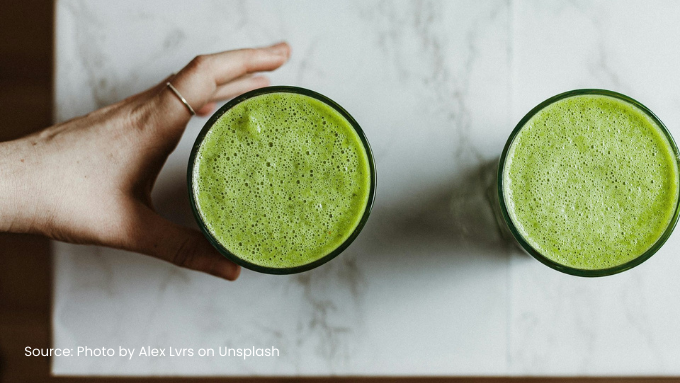Organoleptic Tests and Acceptance of Extract Kencur Mung Beans as Functional Foods

Downloads
Background: Mungbeans contain vitamin B6, vitamin C and vitamin E that function to regulate reproductive hormones to the maximum and natural antioxidants that counter free radicals. Kencur is one of the herbal plants that grows fertile in mountainous areas and is often used as a cure, including cough, nausea, swelling, bruising, diarrhea and antitoxins. In 2017, the total production of kencur in Indonesia reached 36,655 tons. Innovation and creation are needed in processing the combination of these two food ingredients to increase the sales value because of the abundance of the production of mungbeans and kencur in Indonesia. The development of processed products of mungbeans and kencur is expected to be accepted by the general public because of its health benefits.
Objectives: This study aims to find out the acceptance of extract kencur mungbean products and the benefit of mungbean and kencur as healthy foods that are acceptable to consumers.
Methods: The design used in this study was a trial or experiment research. The research was carried out on 5 trained panels and 30 untrained panels who would perform organoleptic tests on one product, namely, extract kencur mung beans.
Results: According to the organoleptic test results on extract kencur mung bean, the panelists liked the taste, color, smells and texture indicators. It can be seen from the test results on the indicators of taste, color, smells, and texture that the panelist likes the preferred category. Whereas in the acceptance test using the hedonic test, the results obtained were, 10 out of 35 panelists chose very like it and 19 out of 35 panelists chose to like the product extract kencur mung bean.
Conclusion: Mungbeans are acceptable and preferred by consumers in terms of taste, colour, smells, and texture.
Anggraeny, E. Tjandrakirana, Ducha, N. (2014) ‘Pengaruh Pemberian Filtrat Tauge Kacang Hijau terhadap Histologi Hepar Mencit Yang Terpapar MSG', LenteraBio: Berkala Ilmiah Biologi [Preprint].
Aprianto Salman, S., Hermanto and Isamu, T.K. (2018) ‘Subtitusi Tepung Rumput Laut (Eucheuma Cottonii) pada Pembuatan Cookies [Substitution of Seaweed Flour (Eucheuma cottonii) in Making of Cookies]', J. Sains dan Teknologi Pangan, 3(5), pp. 1713–1723.
[BPS]. 2018. Statistik Tanaman Biofarmaka Indonesia. Subdirektorat Statistik Hortikultura. Jakarta(ID): Indonesia. 71h. ISSN: 2339-095
Elisabeth, D.A.A. et al. (2021) ‘Kemampuan Daya Saing Kacang Hijau di Tingkat Usahatani pada Lahan Salin (Studi Kasus di Desa Gesik Harjo, Kecamatan Palang, Kabupaten Tuban)', Buletin Palawija, 19(2), p. 93. Available at: https://doi.org/10.21082/bulpa.v19n2.2021.p93-102.
Faradilla, R.H.F. and Ekafitri, R. (2012) ‘Potensi Pemanfaatan Kacang Hijau dan Tauge dalam Olahan Pangan', Jurnal Pangan, 21(2), pp. 197–208.
Manzalina, N., Sufiat, S. and Kamal, R. (2019) ‘Daya Terima Konsumen Terhadap Citarasa Es Krim Buah Kawista (Limonia Acidissima)', Media Pendidikan, Gizi, dan Kuliner, 8(2), pp. 20–27. Available at: https://doi.org/10.17509/boga.v8i2.21956.
Negara J. K., Sio A. K., Rifkhan R., Arifin M., Oktaviana A. Y., Wihansah R. R. S., & Yusuf M. (2017) ‘Aspek mikrobiologis, serta Sensori (Rasa, Warna,Tekstur, Aroma) Pada Dua Bentuk Penyajian Keju yang Berbeda', Jurnal Ilmu Produksi dan Teknologi Hasil Peternakan, 4(2), pp. 286–290. Available at: https://doi.org/10.29244/jipthp.4.2.286-290.
Nindyawati, L., Ina, P.T. and Wiadnyani, A.A.I.S. (2019) ‘Pengaruh Perbandingan Kentang Kukus dan Tepung Kacang Hijau (Phaseolus Radiatus L.) terhadap Karakteristik Flakes', Jurnal Ilmu dan Teknologi Pangan (ITEPA), 8(1), p. 66. Available at: https://doi.org/10.24843/itepa.2019.v08.i01.p08.
Ningrum, S.A. et al. (2022) ‘Pemanfaatan Famili Zingiberaceae di Pasar Grobogan Sebagai Bahan Imunitas di Masa Pandemi Covid-19', ... Nasional Sains & ..., 1(1), pp. 61–68. Available at: http://103.98.176.39/index.php/snse/article/view/3393%0Ahttp://103.98.176.39/index.php/snse/article/download/3393/1827.
Nugraha, R.A. (2020) ‘Pemanfaatan Tepung Pisang Kepok Putih Dan Tepung Kacang Hijau Dalam Pembuatan Crispy Cookies Sebagai Snack Sumber Serat Dan Rendah Natrium', ARGIPA (Arsip Gizi dan Pangan), 4(2), pp. 94–106. Available at: https://doi.org/10.22236/argipa.v4i2.4037.
Nurung, S.H.H. (2016) ‘Penentuan Kadar Total Fenolik, Flavonoid, dan Karotenoid Ekstrak Etanol Kecambah Kacang Hijau (vigna radiata L.) menggunakan Spektrofotometer UV-VIS (skripsi)', Skripsi, p. 80
Regianto, H. (2009) ‘Minyak Atsiri Rimpang Kencur (Kaempferia Galanga L.) Karakterisassimplisia, Isolasi, dan Analisis Komponen Minyak Atsiri secara Gc-Ms', SKRIPSI [Preprint].
Saraswati, A. (2017) ‘Pada Pembuatan Sari Kacang Hijau ( Vigna radiata ) Atika Cantia Saraswati Skripsi Ini Ditulis Untuk Memenuhi Sebagian Persyaratan Dalam Memperoleh Gelar Sarjana Pendidikan Program Studi Pendidikan Tata Boga'.
Septiani, A.R., Susyani, S. and Telisa, I. (2022) ‘Daya Terima Dan Uji Proksimat Sereal Instan Salviza Dengan Bahan Dasar Bekatul, Biji Chia Dan Tepung Kacang Hijau Sebagai Minuman Alternatif Penanggulangan Obesitas Remaja', JPP (Jurnal Kesehatan Poltekkes Palembang), 17(1), pp. 55–62. Available at: https://doi.org/10.36086/jpp.v17i1.1167.
Syamsuri, S. and Alang, H. (2021) ‘Inventarisasi Zingiberaceae yang Bernilai Ekonomi (Etnomedisin, Etnokosmetik dan Etnofood) di Kabupaten Kolaka Utara, Sulawesi Tenggara, Indonesia', Agro Bali : Agricultural Journal, 4(2), pp. 219–229. Available at: https://doi.org/10.37637/ab.v4i2.715.
Tarwendah, I.P. (2017) ‘Studi Komparasi Atribut Sensori dan Kesadaran Merek Produk Pangan', Jurnal Pangan dan Agroindustri, 5(2), pp. 66–73.
Wea, A.S.Y., Widodo, R. and Pratomo, Y.A. (2014) ‘Evaluasi Kualitas Produk Susu Kecambah Konsentrasi Na-CMC', Jurnal Teknik Industri, 11(1), pp. 61–79.Winarno, F. G,
Octaria Andieta (2020). Pewarna Makanan Alami Indonesia. Jakarta: PT. Gramedia Pustaka Utama.
Winarti, Sri. (2010). Makanan Fungsional. Yogyakarta: Graha Ilmu
Yuliantini, E. (2018) ‘Penampilan dan Rasa Makanan sebagai Faktor Sisa Makanan Pasien Anak di Rumah Sakit dr. Sobirin Musi Rawas', Jurnal Media Kesehatan, 8(2), pp. 184–189. Available at: https://doi.org/10.33088/jmk.v8i2.282.
Copyright (c) 2024 Wahyu Rahmadiana, Farapti

This work is licensed under a Creative Commons Attribution-ShareAlike 4.0 International License.
Media Gizi Kesmas by Unair is licensed under a Creative Commons Attribution-ShareAlike 4.0 International License.
1. The journal allows the author(s) to hold the copyright and to retain the publishing right of the article without restrictions.
2. The legal formal aspect of journal publication accessibility refers to Creative Commons Attribution-Share-Alike (CC BY-SA).
3. The Creative Commons Attribution-Share-Alike (CC BY-SA) license allows re-distribution and re-use of a licensed work on the conditions that the creator is appropriately credited and that any derivative work is made available under "the same, similar or a compatible license”. Other than the conditions mentioned above, the editorial board is not responsible for copyright violations.



















